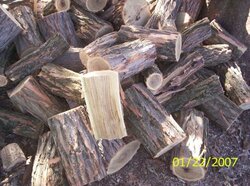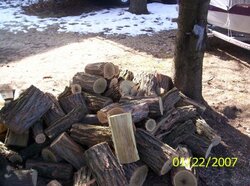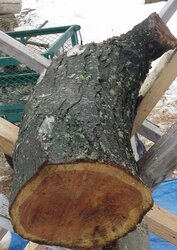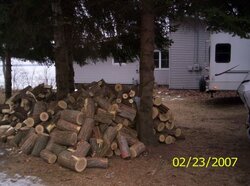LOCUST PIC?
- Thread starter Todd
- Start date
-
Active since 1995, Hearth.com is THE place on the internet for free information and advice about wood stoves, pellet stoves and other energy saving equipment.
We strive to provide opinions, articles, discussions and history related to Hearth Products and in a more general sense, energy issues.
We promote the EFFICIENT, RESPONSIBLE, CLEAN and SAFE use of all fuels, whether renewable or fossil.
You are using an out of date browser. It may not display this or other websites correctly.
You should upgrade or use an alternative browser.
You should upgrade or use an alternative browser.
- Status
- Not open for further replies.
DiscoInferno
Minister of Fire
Roospike
New Member
Bushfire
Burning Hunk
Eric Johnson
Mod Emeritus
It's either black or honey locust. My vote goes with honey. Either way, it's probably the best wood you can burn.
budman
Minister of Fire
I'll have to agree with Eric, i have five cords of black in the yard and that looks
a little different.You will stay warm with this stuff.
a little different.You will stay warm with this stuff.
DiscoInferno
Minister of Fire
Does "wild" honey locust have the thick ridged bark like black locust? The only honey locust I've seen was more ornamental; it had a thin smoother bark, nothing like the pictures.
yukiginger
Member
- Nov 20, 2005
- 228
fespo
Minister of Fire
stoveguy2esw
Minister of Fire
the best part is its already cut to length, that stuff is rough on the chainsaw chain, dulls it quickly, man its a great long burn wood, gives off super high btu's as well , great score. i used to scrounge it around here and there and save it for really cold nights , heats better than oak in my stove.
babalu87
New Member
He shoots he SCORES

Wont take much of that to burn all night either, could be the best firewood EVER ..................... well besides Red Oak


Wont take much of that to burn all night either, could be the best firewood EVER ..................... well besides Red Oak

colsmith
Feeling the Heat
I also have some locust that I am puzzled about. It came from a nice couple who didn't know the type, but were sure it was locust, ditto for the wood cutter dude. It wasn't thorny, and it was really heavy, so I guessed black locust. But it is easy to split (in the fairly green state) and most charts I can find say black locust is hard to split, so I think thornless honeylocust. Also, hubby says the smell reminds him of locust trees in his family's church parking lot, and the smell they gave off when you ran over the blossoms on the ground or something. Read that the honeylocust smells more than the black locust.
Those are my clues. Hope I haven't mixed up the photo and this is of the alleged elm. Of course, that is also fairly easy to split, so I am guessing it is slippery/red elm, which is not hard to split like its friends (lucky me!) They are both REALLY heavy compared to the maple we got from the same folks. Anyway, any suggestions on how to know what kind of locust? Also, are there some other choices? Like I have a Sunburst Locust at another house we own, that is a named hybrid I suppose.
Those are my clues. Hope I haven't mixed up the photo and this is of the alleged elm. Of course, that is also fairly easy to split, so I am guessing it is slippery/red elm, which is not hard to split like its friends (lucky me!) They are both REALLY heavy compared to the maple we got from the same folks. Anyway, any suggestions on how to know what kind of locust? Also, are there some other choices? Like I have a Sunburst Locust at another house we own, that is a named hybrid I suppose.
Attachments
DiscoInferno
Minister of Fire
Now that looks exactly like the (ornamental) honey locust I have.
I'm not sure why the charts list black locust as hard to split; I found that even large rounds split easily. For smaller pieces I only use half swings most of the time. It's so hard that it's brittle, both green and bone-dry. Sounds like stone or metal when a split lands on a hard surface.
I'm not sure why the charts list black locust as hard to split; I found that even large rounds split easily. For smaller pieces I only use half swings most of the time. It's so hard that it's brittle, both green and bone-dry. Sounds like stone or metal when a split lands on a hard surface.
colsmith
Feeling the Heat
I am thinking thornless honeylocust for mine, too, most of the clues point that way, although the bark is really black and I swear our other locust trees (also somewhat decorative and probably thornless honeylocusts) have different and lighter bark. I am starting to think the people who make up wood charts are just toying with us. The one chart that lists mulberry says it is easy to split, but I can barely split the smallest pieces. They must mean "splits easily when really dry," because it is over 4 months since cutting and shows no signs of wanting to split yet. The newer locust and elm (must be red elm?) split much more easily. So I am scratching my head and wondering what to believe. It is true that the locust almost breaks or cracks in half, at least it did when I was splitting it in the freezing cold in recent weeks (which did nothing to help the mulberry.) Also saw wildly varying reports on BTUs from honeylocust from one chart to another. Some say almost the same as black locust, some say much less. Do wood experts drink a lot or ?
DiscoInferno
Minister of Fire
Are you confusing the elm and the mulberry? Fresh-split mulberry is a distinctive bright mustard yellow that turns a rich brown after exposure. The elm I've got is just white. I've always found mulberry easy to split, even though it rarely grows straight. It's brittle like black locust. Elm, on the other hand, is the bane of many a hand-splitter; it's very stringy.
From what I've read, there are other types of Locust such as water/swamp and brisky Locust. Maybe I have one of those? Anyway, I'm off to get more. I figure to get 3 cords by this weekend.
colsmith
Feeling the Heat
DiscoInferno, was your mulberry dry when you split it? I am not having any luck with it. Managed to split some smallish pieces, but it's a real struggle. No confusion with the elm, they look quite different and they are in different places. Plus mulberry from 2005 is half our wood supply this winter, so I am very familiar with it. We scored more of it last October on freecycle. Very distinctive coloring, it is great how you can tell by the color if the wood is seasoned (it gets SO dark when it dries out.) Last year hubby split all the mulberry, I did the softer woods.
We got elm, locust, and maple, all unknown varieties, via Craigslist in Dec. Was all cut down and in snow, so no species clues from leaves or seeds or anything like that. Those 3 are all lumped together in our woodpiles. The maple is obvious, but the other two I am not so familiar with, so thought maybe I could have them mixed up. But I have split some of each of those 3 different kinds. All quite splittable by hand, so that is why I am thinking slippery (red) elm. The charts say that type is not very hard to split like American and Siberian elm. We did only take the smaller hunks of the elm so we could avoid splitting by just cutting if necessary, but it is splitting. The elm looked similar to the locust when cut, I mean the inner parts, not the bark. After drying a couple months the elm is lightening, whereas the locust has stayed colorful in the center.
Todd, sorry for hijacking your thread, but I have been puzzled about our own locust firewood for some time.
We got elm, locust, and maple, all unknown varieties, via Craigslist in Dec. Was all cut down and in snow, so no species clues from leaves or seeds or anything like that. Those 3 are all lumped together in our woodpiles. The maple is obvious, but the other two I am not so familiar with, so thought maybe I could have them mixed up. But I have split some of each of those 3 different kinds. All quite splittable by hand, so that is why I am thinking slippery (red) elm. The charts say that type is not very hard to split like American and Siberian elm. We did only take the smaller hunks of the elm so we could avoid splitting by just cutting if necessary, but it is splitting. The elm looked similar to the locust when cut, I mean the inner parts, not the bark. After drying a couple months the elm is lightening, whereas the locust has stayed colorful in the center.
Todd, sorry for hijacking your thread, but I have been puzzled about our own locust firewood for some time.
DiscoInferno
Minister of Fire
I think I've split mulberry in various states of dryness. Always seemed about the same effort. The splits are typically somewhat twisted, but they seem happy to split along the twisted grain. There are (at least) two varieties of mulberry out there, red and white (I think I have red), so perhaps they have different splitting properties.
Elm, I have less experience with. Just the not-terribly-dense, stringy variety that looks nothing like locust. American elm, I think. Straight pieces are ok, but forget splitting crotches.
Elm, I have less experience with. Just the not-terribly-dense, stringy variety that looks nothing like locust. American elm, I think. Straight pieces are ok, but forget splitting crotches.
pistonslap
Burning Hunk
Definitely locust. I give locust and black cherry a toss-up on which is my favorite to burn. I ran out of both. I've burned at least 4 1/2 cords this season. I sure miss the solid locust heat.
berlin
New Member
op has black locust. 100% sure. i've planted it, burned it, cut it, and have many old black locusts growing on one of my properties; i KNOW that's black locust, one of the best woods to burn.
laynes69
Minister of Fire
I save locust into rounds as much as possible, and use it for overnight fires. Its by far my favorite wood. Splits easily and burns forever. We have all black locust around here and that pile you have will make you one happy camper for firewood. Nice pile, but would look better on my front lawn! The old dead trees are hell on chains though.
- Status
- Not open for further replies.
Similar threads
- Replies
- 14
- Views
- 1K
- Replies
- 41
- Views
- 2K
- Replies
- 14
- Views
- 824
- Replies
- 1
- Views
- 328





